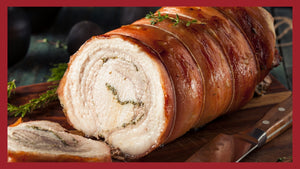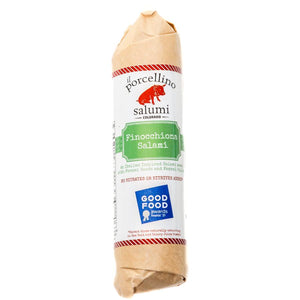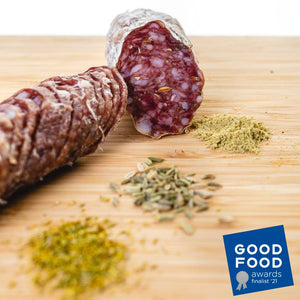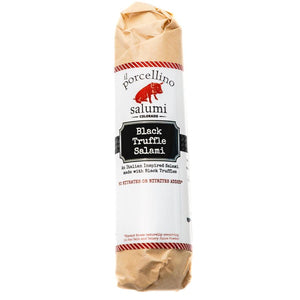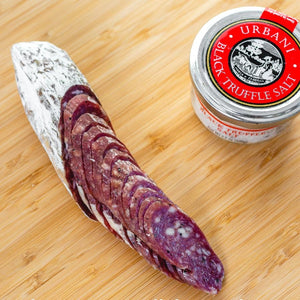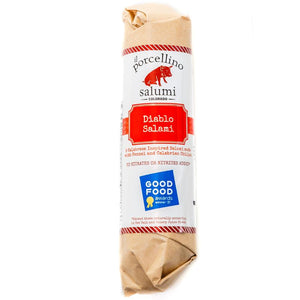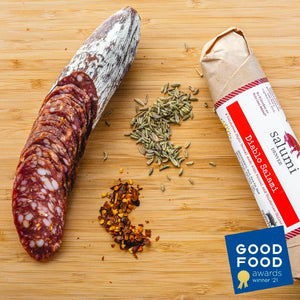Every year il porcellino salumi produces Denver's best porchetta that you can roast at home. I could eat porchetta all year long, and I just might, but it seems to have a boost around the holidays. So, just like our hams, we get busy making a limited amount of house butchered, rolled, and tied porchetta from locally raised Berkshire Pigs.
I like to refer to it as the "King of Pork Roasts" because it really is. There is not another form of roasted pork that tastes better, in my humble opinion. The golden-brown, crispy-skinned roast is a beautiful centerpiece at the holiday dining table. All your guests will be impressed when you pull the rolled pork goodness out of the oven. Good luck letting it rest long enough before cutting it. Plus, the leftovers are excellent on a sandwich, like drool-worthy.

Anyway, let's jump into what porchetta is and why il porcellino makes a damn good one!
What Cut of Meat is Porchetta?
In Italian, porchetta is a suckling pig that has been deboned, seasoned, and roasted. The whole pig is used from head to tail. This porchetta style is the traditional version that is still followed by different regions, producers, and individuals. Who doesn't love a whole deboned pig roast?!

That traditional version has somehow morphed into what we know as porchetta in America today. Now porchetta is recognized as a skin-on, deboned pork belly wrapped around the connected pork loin.
The only proper way to make it is to butcher the hog's midsection to remove the belly with the skin-on and pork loin still intact. Then the rib bones are removed before it's seasoned.

il porcellino salumi’s Handmade Porchetta
At il porcellino salumi, we create the modern version of porchetta with a skin-on pig belly wrapped around the pork loin.

All of our porchetta comes from ethically raised heritage breed pigs from local farmers. Heritage breed pigs are fatter, so their meat is juicier and more flavorful. We only use premium spices and herbs that penetrate the meat with aromatic flavors.
As I noted above, we skillfully remove the pig's midsection with the skin-on and loin intact. Next, we remove the rib bones and prepare the meat for seasoning.
A typical seasoning of porchetta includes fennel, citrus, herbs, and chile flakes. We tend to make almost like a chimichurri-style herb paste that gets rubbed all over the porchetta's inner portion. A simple recipe for this would include 3 bunches of Italian flat-leaf parsley, 2 Tbsp. of fennel pollen, 1 Tbsp. of fresh rosemary, ½ cup of fresh lemon juice, and 1 Tbsp. of red chile flakes.
We blend all of these ingredients in a Vitamix Blender and add about 1 cup of olive oil to bind the herb paste.
To prepare the pork roast properly, we score that pork belly skin with a knife about ⅛" in and ¾" apart to create diamond shapes. Scoring the skin will help the pork belly skin cook properly and get crispy when it is roasted. Once scored, the best practice with any large cut of meat is to season the flesh and skin on both sides generously with salt and pepper. Then rub the underside, or inside of the roast, with the herb paste.

The next step is to tie the roast or to truss it. We use a European-style hemp twine that we purchase from the Craft Butchers' Pantry, which is stronger than a typical butcher's twine. The trick here is to roll the roast and to tie it as tight as humanly possible. I recommend starting in the middle and then work your way to either end an inch at a time. Lots of loops and knots are completed to keep this roast ultra-tight.

Once prepared, a typical porchetta roast weighs about 25 - 30 pounds, depending on the hog's size. That's a huge pork roast, and cooking it properly is essential to end up with a beautiful finished product. We like to let the porchetta roast rest in the refrigerator for at least 24 hours to allow the seasoning to penetrate the meat. It helps create a better pork roast that tastes wonderful!
When it is time to cook the beast (literally), we preheat the convection oven to 500 degrees. The goal here is to cook the porchetta roast on very high heat to crisp the skin. The porchetta goes into a 500-degree oven for approximately 20 minutes to "sear" the outside of it. After 20 minutes, the oven gets turned down to 300 degrees so that the porchetta can cook slowly and evenly for hours. It varies how long it will take to reach an internal temperature of approximately 145 - 150 degrees. The goal here is to achieve a beautiful, crispy outside and a moist, succulent interior that truly melts in your mouth!

Once the porchetta finishes cooking, another secret is to pull the roast out and let it rest at room temperature for a good 20 minutes. If you cut into it immediately, all of those delicious juices that you just spent hours creating will run out, and your roast will eat and taste a little bit dry. So, let it rest and don't touch it!!
After the porchetta rests for 20 minutes, slice it into ½" pieces. It does not need any sauce at all. When porchetta is served hot, it will taste incredibly savory and tender. The meat's juiciness, combined with the seasonings' aromatic flavors, create a roast that melts in your mouth.
Don't scoff at cold porchetta leftovers either! For the next couple of days, shave the porchetta roast nice and thin and enjoy it on ciabatta bread with mayo, arugula, shaved fennel, and charred broccolini. This will be one of the best sandwiches you'll ever eat!

il porcellino salumi's Porchetta comes seasoned, tied, and partially cooked. We provide easy to follow directions, so all you have to do is crisp the skin and bring the meat up to temperature. Our locally sourced heritage breed pigs and premium herbs and spices create an incredibly savory and juicy roast. We're confident that il porcellino salumi makes the best partially cooked porchetta you can buy and roast at home.
For the love of porchetta, order one from il porcellino salumi before we sell out! 303-477-3206 You will thank me later. Happy Holidays!!

